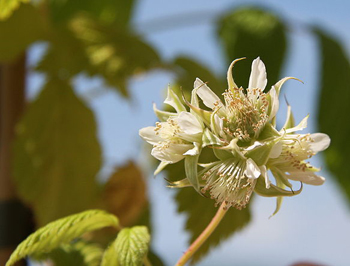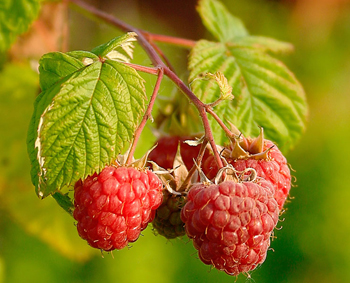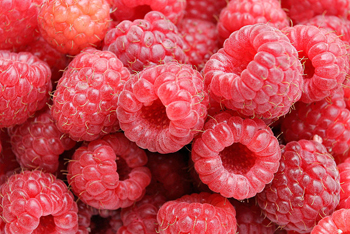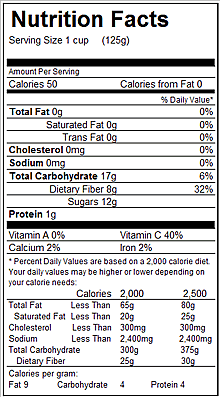Contents:
Common Names | Parts Usually Used | Plant(s) & Culture | Where Found | Medicinal Properties | Biochemical Information
Legends, Myths and Stories | Uses | Formulas or Dosages | Nutrient Content | How Sold | Warning | Bibliography
Scientific Names

- Rubus strigosus L.
- Rubus idaeus L.
- Rosaceae
- Rose family
Common Names
Rubus strigosus L. common names:
- Fu-p’en-tzu (Chinese name)
- Reapberry
- Wild red raspberry
Rubus idaeus L. common names:
- Garden raspberry
- European red raspberry
Parts Usually Used
Bark, leaves, fruit and roots
Back to Top

Description of Plant(s) and Culture
Rubus strigosus L.:
Wild red raspberry is a native shrubby plant; a durable root produces the prickly, biennial stem with alternate, pinnate leaves consisting of 3-5 narrow, oblong-ovate, acuminate leaflets. The white, cup-shaped flowers appear in spring and summer of the second year. The red edible fruit, made up of cohering drupelets, ripens during the summer.
Rubus idaeus L.:
Garden raspberry is a shrubby plant; growing as high as 6 1/2 feet, the biennial stems have few or no prickles and bear alternate, pinnate leaves with 3-7 serrate, broad-ovate to oblong-ovate cordate leaflets which are usually downy white underneath. Clusters of 1-6 white flowers appear in the upper axils during spring and summer of the second year, producing the familiar red fruit which ripens later during the summer.
Back to Top

Where Found
Rubus strigosus L.:
Widespread in thickets and untended fields over North America.
Rubus idaeus L.:
Widely cultivated for its fruit but which also grows wild in and around forests in Europe.
Back to Top

Medicinal Properties
Rubus strigosus L.:
Leaves: alterative, antiemetic, astringent, hemostatic, laxative, stomachic, parturient, tonic, stimulant
Fruit: laxative, esculent, antacid, parturient
Rubus idaeus L.:
Astringent, cardiac, refrigerant
Back to Top
Biochemical Information
Both species:
1 to 2% organic acids of which 90% is citric acid, pectin, sugar, silicon, and vitamins C and D
Back to Top
Legends, Myths and Stories
In days of old, when midwives were the primary health care providers to women, “natural” childbirth was the only way to have a baby. Then, the leaf of the raspberry bush (Rubus idaeus) was the herb of choice. Routinely, women brewed the tea to drink it during the last 2 months of pregnancy. This was to tone the uterine muscles for labor and delivery. After the birth, the tea was continued for several weeks to help the uterus return to normal.
The Chinese name for the red raspberry (Rubus idaeus) is Fu-p’en-tzu, which means “a turned-over bowl” in reference to the shape of the fruit. This common raspberry grows in many parts of the world; including the uplands of the central and western provinces of China.
Back to Top
Uses
Rubus strigosus L.:
Good for diarrhea, dysentery, intestinal flu, vomiting, nausea, hemorrhoids, sores, wounds, and female disorders such as morning sickness, hot flashes, menorrhagia, and menstrual cramps. Strengthens the uterine wall, relaxes uterine and intestinal spasms, and decreases menstrual bleeding. Heals canker sores and promotes healthy nails, bones, teeth, and skin. It was once taken by pregnant women to prevent miscarriage, increase milk, and reduce labor pains. Fresh raspberries are mildly laxative. American raspberry has a good reputation for reducing miscarriage but other varieties are known to promote abortion.
Rubus idaeus L.:
As with its wild cousin above, garden raspberry makes a leaf tea that is good for diarrhea, menstrual cramps, cystitis, and is a good beverage. Sometimes it is used as a gargle for sore throat, a mouthwash for sores in the mouth, or as an external wash for sores, wounds, skin rashes, etc. Fresh juice, mixed with a little honey, used to reduce fever. Made into a syrup or taken with wine vinegar, the juice is said to have a beneficial effect on the heart.
Back to Top
Formulas or Dosages
Rubus strigosus L.:
Infusion: steep 1 oz. leaves or dried herb in 2 cups water for 15 minutes, covered. Take 1 to 2 cups a day. Add a little honey, if desired.
Rubus idaeus L.:
Infusion: steep 1 to 2 tbsp. leaves in 1/2 cup water. Take 1 cup a day. Add a little honey, if desired.
Extract: mix 15 to 30 drops in warm water for best results. Take 3 times per day.
Tea: drink 1 cup of tea per day.
Syrup: cook 7 parts fresh juice with 10 parts sugar until the desired consistency is obtained.
Vinegar: mix 1 part raspberry syrup with 2 parts wine vinegar.
Back to Top
Nutrient Content
Vitamins A, B, C, E, and D

How Sold
Fresh fruit, dried fruit, powdered leaves
Back to Top
Warning
May interfere with iron absorption when taken internally.
Care should be taken in cases of chronic constipation.
American raspberry has a good reputation for reducing miscarriage but other varieties are known to promote abortion.
Do not take during pregnancy until the last 2 months, and then only under the supervision of a qualified health practitioner.
Back to Top
Bibliography
![]() The Herb Book
The Herb Book, by John Lust, Bantam Books, 666 Fifth Avenue, New York, NY. copyright 1974.
![]() The Herbalist Almanac
The Herbalist Almanac, by Clarence Meyer, Meyerbooks, publisher, PO Box 427, Glenwood, Illinois 60425, copyright 1988, fifth printing, 1994
 Earl Mindell’s Herb Bible
Earl Mindell’s Herb Bible, by Earl Mindell, R.Ph., Ph.D., Simon & Schuster/Fireside, Rockefeller Center 1230 Avenue of the Americas, New York, New York 10020
![]() Back to Eden
Back to Eden, by Jethro Kloss; Back to Eden Publishing Co., Loma Linda, CA 92354, Original copyright 1939, revised edition 1994
![]() Eastern/Central Medicinal Plants
Eastern/Central Medicinal Plants, by Steven Foster and James A. Duke., Houghton Mifflin Company, 215 Park Avenue South, New York, NY 10000
![]() The Nature Doctor: A Manual of Traditional and Complementary Medicine
The Nature Doctor: A Manual of Traditional and Complementary Medicine, by Dr. H.C.A. Vogel; Keats Publishing, Inc., 27 Pine Street (Box 876) New Canaan, CT. 06840-0876. Copyright Verlag A. Vogel, Teufen (AR) Switzerland 1952, 1991
 The Magic of Herbs
The Magic of Herbs, by David Conway, published by Jonathan Cape, Thirty Bedford Square, London, England. (Out of print)
![]() Planetary Herbology
Planetary Herbology, by Michael Tierra, C.A., N.D., O.M.D., Lotus Press, PO Box 325, Twin Lakes. WI 53181., Copyright 1988, published 1992
![]() The Complete Medicinal Herbal
The Complete Medicinal Herbal, by Penelope Ody, Dorling Kindersley, Inc, 232 Madison Avenue, New York, NY 10016, First American Edition, copyright 1993
![]() Indian Herbalogy of North America
Indian Herbalogy of North America, by Alma R. Hutchens, Shambala Publications, Inc., Horticultural Hall, 300 Massachusetts Avenue, Boston, Massachusetts 02115, 1973
![]() American Folk Medicine
American Folk Medicine, by Clarence Meyer, Meyerbooks, publisher, PO Box 427, Glenwood, Illinois 60425, 1973
![]() Prescription for Nutritional Healing, Fifth Edition: A Practical A-to-Z Reference to Drug-Free Remedies Using Vitamins, Minerals, Herbs & Food Supplements
Prescription for Nutritional Healing, Fifth Edition: A Practical A-to-Z Reference to Drug-Free Remedies Using Vitamins, Minerals, Herbs & Food Supplements, by James F. Balch, M.D. and Phyllis A. Balch, C.N.C., Avery Publishing Group, Inc., Garden City Park, NY
![]() Webster’s New World Dictionary
Webster’s New World Dictionary, Third College Edition, Victoria Neufeldt, Editor in Chief, New World Dictionaries: A Division of Simon & Schuster, Inc., 15 Columbus Circle, New York, NY 10023
 How Indians Use Wild Plants for Food, Medicine & Crafts
How Indians Use Wild Plants for Food, Medicine & Crafts, by Frances Densmore, Dover Publications, Inc., 180 Varick Street, New York, NY 10014, first printed by the United States Government Printing Office, Washington, in 1928, this Dover edition 1974
 An Instant Guide to Medicinal Plants
An Instant Guide to Medicinal Plants, by Pamela Forey and Ruth Lindsay, Crescent Books (January 27, 1992).
 The Magic of Herbs in Daily Living
The Magic of Herbs in Daily Living, by Richard Lucas, Parker Publishing Co. (1988).
 Secrets of the Chinese Herbalists
Secrets of the Chinese Herbalists, by Richard Lucas, Parker Publishing Company, Inc., West Nyack, NY, 1987.
![]() The Yoga of Herbs: An Ayurvedic Guide to Herbal Medicine
The Yoga of Herbs: An Ayurvedic Guide to Herbal Medicine, by Dr. David Frawley & Dr. Vasant Lad, Lotus Press, Twin Lakes, Wisconsin, Second edition, 1988.
 The Healing Plants
The Healing Plants, by Mannfried Pahlow, Barron’s Educational Series, Inc. 250 Wireless Blvd., Hauppauge, NY 11788, 1992
